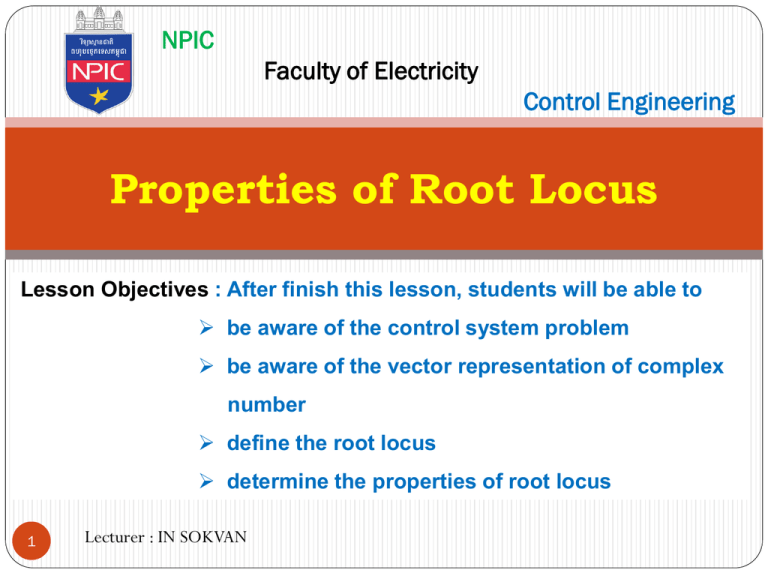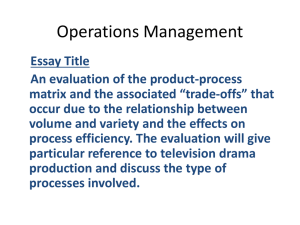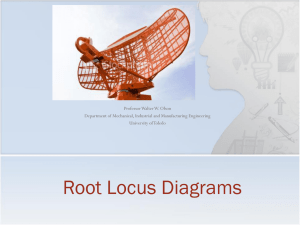Properties of Root Locus
advertisement

NPIC Faculty of Electricity Control Engineering Properties of Root Locus Lesson Objectives : After finish this lesson, students will be able to be aware of the control system problem be aware of the vector representation of complex number define the root locus determine the properties of root locus 1 Lecturer : IN SOKVAN Lesson Objectives 01 Aware of Control System Problem 2 Lecturer : IN SOKVAN The Prerequisites To Root Locus Technique 1. Understanding the control system problems 2. Vector representation of complex numbers 3 Lecturer : IN SOKVAN The Control System Problem General Feedback Control System Open Loop Transfer Function Also called, Loop Gain KG ( s ) H ( s ) Closed-loop Transfer Function T (s) 4 Lecturer : IN SOKVAN KG ( s ) 1 KG ( s ) H ( s ) The Control System Problem What is the control system problem? Difficult to obtain the poles Poles location varied with the gain T (s) KG ( s ) 1 KG ( s ) H ( s ) Let’s find the closed-loop transfer function K T CL ( s ) KG ( s ) 1 KG ( s ) H ( s ) N G (s) DG (s) 1 K N G (s) N H (s) K DG (s) D G ( s ) D H ( s ) KN G ( s ) N H ( s ) DG (s) D H (s) K N G (s) DG (s) DG (s) D H (s) D G ( s ) D H ( s ) KN G ( s ) N H ( s ) TOL ( s ) KG ( s ) H ( s ) 5 Lecturer : IN SOKVAN KN G ( s ) N H ( s ) DG ( s ) D H ( s ) N G (s) DG (s) D H (s) KN G ( s ) D H ( s ) D G ( s ) D H ( s ) KN G ( s ) N H ( s ) The Control System Problem Comparison Between Open Loop and Closed Loop Systems T OL ( s ) KN G (s) N H (s) DG (s) D H (s) OL poles are roots of: 1. Forward transfer function denominator 2. Feedback transfer function denominator T CL ( s ) KN G (s)D H (s) D G ( s ) D H ( s ) KN G (s) N H (s) CL poles are roots of: 1. Combinations of numerator and denominator of forward and feedback transfer functions 2. Poles depend on gain, K Therefore, with CL system, the poles are not easily obtained and change with the value of K 6 Lecturer : IN SOKVAN The Control System Problem - Example Given: Open Loop System G (s) H (s) s 1 s(s 2) s3 s4 T OL ( s ) K ( s 1)( s 3 ) Poles: 0, -2 and -4 s ( s 2 )( s 4 ) Closed-loop System T CL ( s ) T CL ( s ) KN G (s)D H (s) D G ( s ) D H ( s ) KN G (s) N H (s) K ( s 1)( s 4 ) s ( s 2 )( s 4 ) K ( s 1)( s 3 ) Poles: We have to factor and also depends on K. Root locus technique help to find poles! 7 Lecturer : IN SOKVAN Lesson Objectives 02 Aware of the Vector Representation of Complex Number 8 Lecturer : IN SOKVAN Vector Representation of Complex Number What is complex number? s j Complex number is a vector Vector has magnitude and direction M tan 2 1 2 Therefore, we can also represent complex number s as: s M 9 Lecturer : IN SOKVAN Vector Representation of Complex Number But, if s is a variable in a function, how to represent the complex number. For example, F (s) s a Replacing s, F ( s ) s a j a F ( s ) a j Another complex number 10 Lecturer : IN SOKVAN Graphically, Vector Representation of Complex Number s j F ( s ) s a j a F ( s ) a j 11 Lecturer : IN SOKVAN Vector Representation of Complex Number Same Vector s 5 j2 Same Vector F (s) s 3 j F (s) 5 3 j2 8 j2 2 3 5 8 is a complex number and can be represented by a vector drawn from the zero of the function to the point s. F (s) s a 12 Lecturer : IN SOKVAN Vector Representation of Complex Number General F (s) M m m (s z ) i F (s) i 1 n (s p M j ) zero length pole length (s zi ) (s p j ) j 1 i 1 n j 1 zero angles poles angle m s z i 1 13 Lecturer : IN SOKVAN n i s j 1 pj Vector Representation of Complex Number Example F (s) s 1 s(s 2) 20 116 . 6 s 3 j4 What is F(s)? F (s) 20 17 104 . 0 116 . 6 126 . 9 104 . 0 5 17 F ( s ) 0 . 217 114 . 3 14 Lecturer : IN SOKVAN 5126 . 9 Lesson Objectives 03 define the root 15 Lecturer : IN SOKVAN locus What is Root Locus? The root locus is the path of the roots of the characteristic equation shown out in the s-plane as a system parameter is changed. 16 Defining Root Locus 17 Lecturer : IN SOKVAN Defining Root Locus 18 Lecturer : IN SOKVAN Defining Root Locus Root Locus 19 Lecturer : IN SOKVAN Defining Root Locus Root Locus Representation of the paths of closedloop poles as the gain is varied What can we learn from this graphic? 0<K<25 The system is over-damped K=25 The system is critically damped K>25 The system is under-damped The system is stable 20 Lecturer : IN SOKVAN Lesson Objectives 04 Determine the properties of root locus 21 Lecturer : IN SOKVAN Properties of Root Locus T (s) j KG ( s ) 1 KG ( s ) H ( s ) How do we get poles? 180 1 KG ( s ) H ( s ) 0 KG ( s ) H ( s ) 1 The value “-1” is a complex number 1 KG ( s ) H ( s ) 1 1 180 M 1 ( 2 k 1)180 22 Lecturer : IN SOKVAN Properties of Root Locus Magnitude Condition KG ( s ) H ( s ) 1 1 180 j KG ( s ) H ( s ) 1 K 180 1 G (s)H (s) Angle condition 1 KG ( s ) H ( s ) 1 1180 KG ( s ) H ( s ) ( 2 k 1)180 k 0 ,1, 2 , 23 Lecturer : IN SOKVAN Properties of Root Locus - Example Given a unity feedback system forward transfer function G (s) K (s 2) 2 ( s 4 s 13 ) 1. Is point -3+0j is on a root locus? 2. If the point is on the root locus, find the value of K? 24 Lecturer : IN SOKVAN Steps: 1. Determine zeros and poles of the forward transfer function 2. Determine angles from zeros and poles to the interested point 3. Determine the length of vector from zeros and poles to the interested point 4. Add all angles. If it is equal to multiple of 180, then the point is on the root locus. 5. Determine K using length of zero and pole vectors Properties of Root Locus - Example 1. Determine zeros and poles of the forward transfer function Using quadratic equation, G (s) G (s) 25 b 2 b 4 ac 2a K (s 2) ( s 4 s 13 ) j 3 2 K (s 2) ( s 2 j 3 )( s 2 j 3 ) Lecturer : IN SOKVAN 3 2 3 Properties of Root Locus - Example 2. Determine angles from zeros and poles to the interested point 1 j 3 2 3 2 26 2 180 3 Lecturer : IN SOKVAN 1 251 . 57 3 3 90 tan 3 1 270 tan 1 1 1 108 . 43 3 Properties of Root Locus - Example 3. Determine the length of vector from zeros and poles to the interested point j 3 L1 L1 L2 3 L3 27 2 3 Lecturer : IN SOKVAN 2 2 10 2 2 10 3 1 L2 1 L3 3 1 Properties of Root Locus - Example 4. Add all angles. If it is equal to multiple of 180, then the point is on the root locus. 1 251 . 57 2 180 3 108 . 43 2 ( 1 3 ) 180 251 . 57 108 . 43 180 Therefore, the point -3+0j is a point on the root locus 28 Lecturer : IN SOKVAN Properties of Root Locus - Example 5. Determine K using length of zero and pole vectors L1 K 2 3 1 2 L2 1 10 1 G (s)H (s) 1 M M K 1 M 29 Lecturer : IN SOKVAN L3 2 3 1 zero length pole length 10 2 10 1 10 10 1 10 Home work Given a unity feedback system forward transfer function a / . G (s) K ( s 2 )( s 6 ) ( s 8 s 25 ) 2 K ( s 1) 2 , b / . G (s) 2 c /. G ( s ) s 2 K (s 4) , d /. G ( s ) ( s 1) 2 K ( s 1) ( s 4 ) 3 1. Is point -3+0j is on a root locus? 2. If the point is on the root locus, find the value of K? 30 Lecturer : IN SOKVAN




